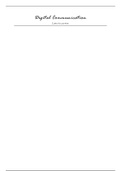Digital Communication
Lectures
, Lecture 1
4-09-2018
Introduction
Digital comes from the Latin Digitus, which means ‘finger’
- numbers were counted on fingers ® if something is digital, it can be counted discretely e.g. 0,
1, 2, 3, 4 etc.
- the simplest digital system is 0 and 1 (e.g. on and off)
The opposite of digital is analogue = a number that is continuous ® no discrete numbers
Analogue can be turned into digital
The boundaries are blurred:
- digital audio recordings often use analogue equipment for effect
- digital techniques try to simulate analogue effects e.g. Instagram filters, fake handwriting in e-
mails
Spoken language can be both digital and analogue;
Digital ® letters, words, sentences
Analogue ® volume, pitch, duration
Digital changes immediately into something different, whereas analogue ‘fades’ into something
different
Types of digital communication
1. Machine with machine ® USB, Wifi, bluetooth
2. Human with human (through a computer) ® Whatsapp, Skype, Facebook
3. Human with machine (conversation) ® Siri
4. Human with interface ® DVD player menu, pilot controls in aeroplane
In face-to-face communication, people can instantly see and hear each other’s communicative
behaviour.
In computer-mediated communication, this is not possible ® communication between humans
via computers
- the problem with textchat is that it isn’t clear who’s responding to who
Human computer interaction ® interaction between computer and human
Human robot interaction ® interaction between human and robot
1
,The history of digital communication
Communicating over large distances ® slit-drums = one of the first systems to communicate
over large distances, found all over the world
There were three ways of communicating with the drums
1. Making music together
2. Encoding messages with specific patterns
e.g. “Dum-dum-di-dum-dah” ® this is fully digital communication!
3. Copying the patterns of speech ® drum beats copy the rhythm, stress and intonation of well-
known spoken phrases
Greek hydraulic semaphore system (350 B.C.) ® interesting, because the messages weren’t
send, but selected from a pre-existing list
Optical telegraphs (semaphore) ® first successful optical telegraph by Claude Chappe (1792) ®
used to communicate about battles, taxes, send news ® fully digital communication
The messages sent were encoded before they were transmitted ® messages could not be read
by the station operators of by other people, only senior officials had a copy of the codebook
The system also had special control signals e.g. “Message understood”, “Please repeat” etc. ®
important, because these signals are also found in speech: “What?”, “I follow”, “OK”
Sommering’s electric telegraph (1809) ® used 35 wires to represent all the Latin letters, the
sender passes an electric current through the wire for each letter, the receiver reads what letter
is sent by seeing where the bubbles form in the tower
Samuel Morse invented ‘Morse Code’ ® truly digital ® was successful because of its simplicity,
it only needed 2 cables
The telegraph transformed society ® it enabled the sending of information that was dependent
on time, this was an entirely new category of communication
The British empire tried to dominate the world ® cables all over the world around 1850 ® lead
to Victorian Internet (1870)
Lecture 2
6-09-2018
History and Future of Digital Communication
In Morse code you only have two signals: a dot and a dash ® same principle is used in ZIP files
® these things consist in all sorts of dimensions
The key of Morse code became smaller and smaller and eventually this led to the invention of
the telephone (1880, Alexander Graham Bell) ® from digital to analogue
2
, To communicate via telephone, the inventors created a new convention: hello ® has only been
used as a greeting since the telephone. Before, it was used as a way of attracting attention or as
a mild form of surprise.
There were instructions to start a telephone talk, because people didn’t know how to use a
telephone.
The first streaming of music started in 1880 ® in cities throughout the world, phone companies
placed telephone microphones in concert halls and theatres ® stereo sound, using 2 phones
People’s telephones were connected to human operators ® just like a telegraph, you weren’t
directly connected with the other human ® the automatic switch got invented for the
telephone, which is the basic thing that is going on on the internet
The automatic switchboard got invented by Strowger ® he wanted to find a way of replacing
human operators
Strowger also solved:
- Unintended human errors
- Speed of making a connection
- Direct dialling
- Lowering the costs of running a local exchange
- Laid the foundation for the automatic switching of the internet
The history of the internet
Developed by military in 1957 ® in that year, Russia launched the first satellite “Sputnik” ® the
U.S. was concerned that this could be used as a weapon and created a special agency: ARPA
(Advanced Research Projects Agency) ® their task was to create a military communication
network that was;
- decentralized: it still had to work if parts of it were destroyed
- able to survive a nuclear attack
® this was done by creating a network with many parallel connections, so it’s difficult to
destroy all of them ® in 1696 the ARPAnet consisted of four interconnected computers at
different universities in the U.S.
The idea of internet network was that when one of them was broken, it should automatically
switch to another network
1971 The first e-mail ® up till then you could only send a message to someone on the same
computer ® Tomlinson invented the @ to separate the user from the machine
1973 ARPAnet (internet) goes international ® at this point email accounted for 75% of all
ARPAnet network traffic!
1984 ARPAnet becomes the internet: a decentralized network of networks
3





